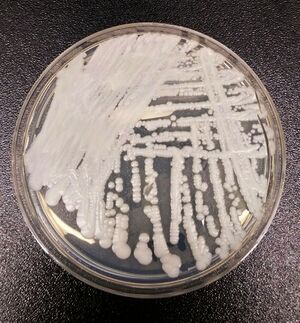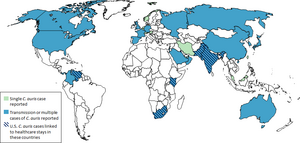Candida auris
Candida auris is a yeast that can cause serious invasive infections . It particularly endangers long-term hospitalized patients with invasive inputs (such as central venous catheters ) or with previous antibiotic or antifungal treatment. The disease can be fatal. The infection was diagnosed in all age groups, from premature infants to the elderly. C. auris is currentlywidespread worldwide.
It is considered a global threat for the following reasons :
- is often multi-resistant to common antifungals;
- is difficult to identify by conventional laboratory methods, may be confused with other yeasts;
- easily spread in medical facilities.
In medical facilities, it can be transmitted directly from person to person or by contact with contaminated surfaces or objects . It causes bloodstream infections ( sepsis ), early infections and ear infections. It has also been isolated from the respiratory tract and urine, but it is not clear whether this is only colonization or whether it causes lung or bladder infections.
Most C. auris infections can be treated with echinocandins , which include caspofungin, anidulafungin and micafungin . However, sometimes C. auris is resistant to all 3 major antifungal groups, which are triazoles, polyenes and echinocandins.
Even after treatment of an invasive infection, colonization may persist for a long time . Asymptomatic colonization of the skin, oropharynx, respiratory tract and urine is not indicated for antifungal therapy. However, colonization is a risk factor for the development of invasive infection and also an infection risk for other patients, so the CDC recommends that these patients be monitored regularly.
It was first identified and named in Japan in 2009. The name ( auris ) is derived from the Latin word for ear, from which it was isolated. A retrospective analysis of the genus Candida identified the oldest representative of C. auris in South Korea in 1996.
The entire C. auris genome was sequenced. C. auris appear to have a similar genome in each region, but there are differences between the regions. Thus, it is possible that C. auris appeared at more than one site at approximately the same time.
Links[edit | edit source]
Reference[edit | edit source]
- ↑Jump up to:a b c d e f g h Centers for Disease Control and Prevention. Candida auris [online]. CDC, © 2019. Last revision 2019-03-29, [cit. 2019-04-14]. < https://www.cdc.gov/fungal/candida-auris/index.html >.
- ↑ HABER, J. Echinocandins - a new group of antifungals. Remedia [online] . 2008, vol. -, vol. 4, p. -, also available from < http://www.remedia.cz/Okruhy-temat/Mikrobiologie-a-infekcni-choroby/Echinokandiny-novaskupina-antimykotik/8-1c-jH.magarticle. aspx >. ISSN 2336-3541.
[edit | edit source]
- Yeast
- Invasive fungal infections
- Antifungals
External links[edit | edit source]
- Current distribution of Candida auris in the world


